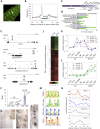Regulatory modules controlling maize inflorescence architecture
- PMID: 24307553
- PMCID: PMC3941108
- DOI: 10.1101/gr.166397.113
Regulatory modules controlling maize inflorescence architecture
Abstract
Genetic control of branching is a primary determinant of yield, regulating seed number and harvesting ability, yet little is known about the molecular networks that shape grain-bearing inflorescences of cereal crops. Here, we used the maize (Zea mays) inflorescence to investigate gene networks that modulate determinacy, specifically the decision to allow branch growth. We characterized developmental transitions by associating spatiotemporal expression profiles with morphological changes resulting from genetic perturbations that disrupt steps in a pathway controlling branching. Developmental dynamics of genes targeted in vivo by the transcription factor RAMOSA1, a key regulator of determinacy, revealed potential mechanisms for repressing branches in distinct stem cell populations, including interactions with KNOTTED1, a master regulator of stem cell maintenance. Our results uncover discrete developmental modules that function in determining grass-specific morphology and provide a basis for targeted crop improvement and translation to other cereal crops with comparable inflorescence architectures.
Figures






Similar articles
-
GIF1 controls ear inflorescence architecture and floral development by regulating key genes in hormone biosynthesis and meristem determinacy in maize.BMC Plant Biol. 2022 Mar 18;22(1):127. doi: 10.1186/s12870-022-03517-9. BMC Plant Biol. 2022. PMID: 35303806 Free PMC article.
-
Molecular Insights into Inflorescence Meristem Specification for Yield Potential in Cereal Crops.Int J Mol Sci. 2021 Mar 29;22(7):3508. doi: 10.3390/ijms22073508. Int J Mol Sci. 2021. PMID: 33805287 Free PMC article. Review.
-
Conservation and divergence: Regulatory networks underlying reproductive branching in rice and maize.J Adv Res. 2022 Nov;41:179-190. doi: 10.1016/j.jare.2022.01.012. Epub 2022 Jan 29. J Adv Res. 2022. PMID: 36328747 Free PMC article. Review.
-
Architecture of floral branch systems in maize and related grasses.Nature. 2005 Aug 25;436(7054):1119-26. doi: 10.1038/nature03892. Epub 2005 Jul 24. Nature. 2005. PMID: 16041362
-
Molecular control of grass inflorescence development.Annu Rev Plant Biol. 2014;65:553-78. doi: 10.1146/annurev-arplant-050213-040104. Epub 2014 Jan 27. Annu Rev Plant Biol. 2014. PMID: 24471834 Review.
Cited by
-
The SvFUL2 transcription factor is required for inflorescence determinacy and timely flowering in Setaria viridis.Plant Physiol. 2021 Nov 3;187(3):1202-1220. doi: 10.1093/plphys/kiab169. Plant Physiol. 2021. PMID: 33871654 Free PMC article.
-
Stable unmethylated DNA demarcates expressed genes and their cis-regulatory space in plant genomes.Proc Natl Acad Sci U S A. 2020 Sep 22;117(38):23991-24000. doi: 10.1073/pnas.2010250117. Epub 2020 Sep 2. Proc Natl Acad Sci U S A. 2020. PMID: 32879011 Free PMC article.
-
A high-resolution gene expression atlas links dedicated meristem genes to key architectural traits.Genome Res. 2019 Dec;29(12):1962-1973. doi: 10.1101/gr.250878.119. Epub 2019 Nov 19. Genome Res. 2019. PMID: 31744902 Free PMC article.
-
Meta Gene Regulatory Networks in Maize Highlight Functionally Relevant Regulatory Interactions.Plant Cell. 2020 May;32(5):1377-1396. doi: 10.1105/tpc.20.00080. Epub 2020 Mar 17. Plant Cell. 2020. PMID: 32184350 Free PMC article.
-
Genome-wide association and high-resolution phenotyping link Oryza sativa panicle traits to numerous trait-specific QTL clusters.Nat Commun. 2016 Feb 4;7:10527. doi: 10.1038/ncomms10527. Nat Commun. 2016. PMID: 26841834 Free PMC article.
References
-
- Ariel FD, Manavella PA, Dezar CA, Chan RL 2007. The true story of the HD-Zip family. Trends Plant Sci 12: 419–426 - PubMed
-
- Berger N, Dubreucq B 2012. Evolution goes GAGA: GAGA binding proteins across kingdoms. Biochim Biophys Acta 1819: 863–868 - PubMed
-
- Bomblies K, Wang RL, Ambrose BA, Schmidt RJ, Meeley RB, Doebley J 2003. Duplicate FLORICAULA/LEAFY homologs zfl1 and zfl2 control inflorescence architecture and flower patterning in maize. Development 130: 2385–2395 - PubMed
Publication types
MeSH terms
Substances
Associated data
- Actions
LinkOut - more resources
Full Text Sources
Other Literature Sources
Molecular Biology Databases
